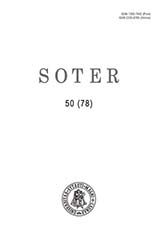Kauno benediktinių vienuolyno Šv. Mikalojaus bažnyčios altorių ikonografijos ir meninės raiškos kaita XVII–XVIII a.
The change of iconography and artistic expression of the altars of Kaunas St. Nicholas (Benedictine) church in the 17th–18th centuries
Author(s): Aušra VasiliauskienėSubject(s): Christian Theology and Religion
Published by: Vytauto Didžiojo Universitetas
Keywords: Kauno Šv. Mikalojaus bažnyčia; Benediktinės; Interjeras; Altoriai; XVII–XVIII a.; Vizitacijos; Tapyba; Ikonografija; Drožyba; Dvasingumas; Kaunas St. Nicholas church; The Benedictines; Interior; Altars; 17th–18th centuries; Visitations; Painting
Summary/Abstract: Gotikinės Kauno Šv. Mikalojaus (benediktinių) bažnyčios interjere šiandien atsispindi 1938–1940 m. rekonstrukcijos sprendimai. Straipsnyje keliamas klausimas, kokia buvo autentiška šios bažnyčios erdvė, kokie altoriai bei kūriniai ją puošė ir ką jie liudijo apie pačias benediktines, jų dvasingumą. Pirmosios žinios apie šventovės interjerą siekia 1700 m., tad apie jos įrangą bei dailę galima kalbėti pradedant XVIII a. ir darant kai kurias prielaidas apie XVII a. Remiantis šaltiniais bei išlikusiais kūriniais, straipsnyje analizuojami Kauno Šv. Mikalojaus (benediktinių) bažnyčios XVII–XVIII a. altoriai, siekiant atskleisti jų vietą bei kaitą interjere, meninę raišką, nustatyti ikonografinės programos ryšį su benediktinių dvasingumu. Išsamesni tyrimai šia tema iki šiol nebuvo publikuoti. Straipsnis parengtas pagal Lietuvos mokslo tarybos finansuotą projektą „Kauno Šv. Mikalojaus bažnyčios ir benediktinių vienuolyno istorija“ (sut. nr. MIP-104/2012). Kaunas St. Nicholas (Benedictine) church, built in the 15th century, presently represents one of the few examples of Gothic that have remained in Lithuania. There are many surviving authentic architectural details on its faēade and in its interior. Alas, we cannot say the same about the heritage of fine arts. In this respect the interior of St. Nicholas Church has experienced dramatic changes. Only one of Baroque altars, dating back to the end of the 17th century, has survived in this church – St. Benedict altar and several old paintings. The main altar of the 18th century which stood in the presbytery has also survived, although during the interwar period it was transferred to Ariogala St. Archangel Michael church in which it remained to this day. Today the solutions of the reconstruction carried out in 1938–1940 predominate in Kaunas Benedictine church. Seeing the current interior one inevitably wonders what the authentic space of this church was, what pieces of art were decorating it and what they told about the very Benedictines and their spirituality. The first information on the interior of Kaunas Benedictine church dates back to 1700, so one can only speak about its equipment and fine arts from the beginning of the 18th century and make certain prerequisites about the 17th century. The object of the article is the altars of Kaunas Benedictine St. Nicholas church of the 17th–18th centuries. Based on the surviving archive sources and pieces of art, the article revealed the altar titles, their place and change in the interior over time, artistic expression, established the ties of the iconographic program with Benedictine spirituality. Principal investigation methods are historical, formal and icon-theological. The article strives to reveal only the essential ties of spirituality and art, artistic altar features and their changes.
Journal: SOTER: religijos mokslo žurnalas
- Issue Year: 78/2014
- Issue No: 50
- Page Range: 115-140
- Page Count: 26
- Language: Lithuanian

